When referring to the arrangement or placement of prepositions in a sentence, the commonly used term is “Preposition Positioning.” It highlights the positioning or placement of prepositions within the sentence structure.
Preposition Positioning
In English grammar, a preposition is used to establish a relationship between its object and other words in a sentence. The preposition typically comes before the nouns, pronouns, or noun phrase that functions as its object.
For example:
- She walked to the store. (The preposition “to” is followed by the noun “store.”)
- He sat on the chair. (The preposition “on” is followed by the noun “chair.”)
- The cat is hiding under the table. (The preposition “under” is followed by the noun “table.”)
निम्न उदाहरणों को देखिए-
- The book is on the table.
- He came here with me yesterday.
पहले वाक्य में ‘is‘ क्रिया है और The book इसका Subject है। ‘on‘ Preposition है। ‘table‘ Noun है और इसका Objective Case है। table का सम्बन्ध on-Preposition से है। table- on द्वारा book से सम्बन्धित है।
दूसरे वाक्य में क्रिया ‘came‘ है और इसका Subject- He है। with– Preposition है और Object- me है जो कि Personal Pronoun है।
उपर्युक्त विवेचन से स्पष्ट है कि Preposition के बाद में प्रयुक्त Noun या Pronoun Preposition का Object होता है।
नोट– Transitive Verb और Preposition के साथ इनके Objects आते हैं।
Position of a Preposition
Preposition वाक्य के आरम्भ, मध्य और अन्त में कहीं भी आ सकता है; जैसे-
- I have done it for you.
- Besides Mohan and Sohan, there were three other boys present.
- Here is the watch that you asked for.
- That is the boy whom I was speaking of.
- What are you looking at?
- What are you thinking of?
- Which of these chairs did you sit on?
उपर्युक्त वाक्यों में for, besides, for, of, at, of, on- Prepositions हैं। इनका प्रयोग सम्बन्धित वाक्यों के अन्त में हुआ है।
Preposition द्वारा निम्न प्रकार के सम्बन्ध प्रकट किये जाते हैं-
Relationship in Time :
कुछ Preposition समयसूचक होते हैं; जैसे-
- Mohan came here at 7 a.m.
- Sarla gets up at 5 o’clock in the morning.
- Father works in the office from 10 to 4.
- There are twelve months in a year.
- I will complete my work before Sunday.
इन वाक्यों में at, at, from, in, before के प्रयोग द्वारा समय व्यक्त किया गया है।
Relationship in Space :
कुछ Preposition स्थानसूचक होते हैं; जैसे-
- Mira was in her room.
- The dog is sitting at the gate.
- Binni is coming from school.
- Put the book on my table.
- Sinni stood before me.
इन वाक्यों में in, on, at, from, before के प्रयोग से स्थान व्यक्त हुआ है।
Relation showing Agency or Instrumentality (माध्यम) :
कुछ Prepositions का प्रयोग माध्यम प्रकट करता है। इस प्रकार के सम्बन्ध प्रकट करने के लिए By, With, Through का प्रयोग होता है। By का प्रयोग व्यक्ति के लिए, With का प्रयोग वस्तु (चाकू, खंजर, तलवार आदि) के लिए और दूर से चलाने वाले हथियारों (बन्दूक, तीर-कमान, भाला, आदि) के लिए By का प्रयोग होता है; जैसे-
- Some trains are run by electricity.
- Anil goes to office by car.
- Sheela cut her finger with a knife.
- The house was destroyed by fire.
- I heard this through a friend.
- The bird was killed by a hunter.
नोट– वाक्य 3 तथा 6 को ध्यान से पढ़िए। व्यक्ति द्वारा कार्य करने पर By का प्रयोग होता है। औजार (यन्त्र) का प्रयोग होने पर With का प्रयोग होता है।
Relationship Showing Manner (कार्यविधि) :
Without, With और Through से कार्यविधि प्रकट होती है; जैसे-
- He solved the problem without any difficulty.
- He met the challenge with courage.
- I have learnt this formula by heart.
- At Sharjah our cricket team won with ease.
- The condition of the patient is critical.
- He is dying by inches.
- He succeeded in the end as he worked with earnest.
Relation showing Cause or Purpose (कारण या उद्देश्य) :
कारण या उद्देश्य प्रकट करने के लिए of तथा For का प्रयोग होता है; जैसे-
- He died of cholera.
- The patient died of a heart attack.
- Mother Teressa did much for the good of the lepers.
- She is doing a lot for the welfare of the weak.
Relation showing Source, Origin and Inference (स्रोत, उद्गम और निष्कर्ष) :
From द्वारा स्रोत, उद्गम और निष्कर्ष व्यक्त किया जाता है; जैसे-
- These lines are from the poem ‘The Seekers’.
- I got this gift from my aunt.
- We get light from the sun.
- Skill comes from practice.
- He did it from gratitude.
Relation showing Measure and Rate (माप, मूल्यदर) :
By का प्रयोग Measure (माप) क लिए जबकि At का प्रयोग Rate (मूल्यदर) प्रदर्शित करने के लिए होता है; जैसे-
- Now cloth is sold by the metre.
- Milk is sold by the litre these days.
- It is four o’clock by my watch.
- Mangoes are sold at ten rupees a kilo in Delhi.
- Mukesh is taller than Mahesh by two inches.
Relation showing Contrast and Concession (विरोध और छूट) :
After, For, With द्वारा Contrast तथा Concession व्यक्त होता है; जैसे-
- After every effort one may fail.
- For one enemy, he has a hundred friends.
- For all his wealth he is not satisfied.
- With all his faults, I admire my friend.
It is important to place the preposition in the correct position to ensure clarity and convey the intended meaning in a sentence.
